List of peasant revolts
This is a chronological list of conflicts in which peasants played a significant role.
Background
History of peasant wars spans over a period of over two thousand years. A variety of reasons fueled the emergence of the peasant revolt phenomenon, including:[1]
- Tax resistance
- Social inequality
- Religious war
- National liberation
- Resistance against serfdom
- Redistribution of land
- External factors such as plague and famine
Later peasant revolts such as the Telangana Rebellion were also influenced by agrarian socialist ideologies.[2]
The majority of peasant rebellions ended prematurely and were unsuccessful. Peasants suffered from limited funding and lacked the training and organisational capabilities of professional armies.[3]
Chronological list
The list gives the name, the date, the peasant allies and enemies, and the result of these conflicts following this legend:
- Peasant victory
- Peasant defeat
- Another result (e.g. a treaty or peace without a clear result, status quo ante bellum, result unknown or indecisive)
- Ongoing conflict
| Date | Conflict | State | Peasants | Result | Image | References | |
|---|---|---|---|---|---|---|---|
| 209–206 BC | Anti-Qin revolts (including Dazexiang Uprising) | Qin dynasty | Peasants under several rebel leaders, including Chen Sheng, Wu Guang, Xiang Yu, and Liu Bang | Qin dissolution | [4] | ||
| 205–186 BC | Great revolt of the Egyptians | Native Egyptian peasants and soldiers under secessionist Pharaohs Hugronaphor and Ankhmakis | Suppression of the rebellion | [5] | |||
| 17–25 | Lülin | Xin dynasty | Lülin rebels | Collapse of Xin dynasty; ascendancy of rebel leader Liu Xiu after infighting among Lülin forces | |||
| 17–27 | Red Eyebrows | Xin dynasty | Red Eyebrows rebels | Goal of the rebellion partially achieved, but eventual defeat of the movement by Liu Xiu | |||
| 172–173 | Bucolic War | Egyptian peasants under Isidorus | Suppression of the rebellion | [6] | |||
| 184–205 | Yellow Turban Rebellion | Han dynasty | Yellow Turban rebels | Suppression of the rebellion, though Han dynasty is severely weakened |  |
[7] | |
| 185–205 | Heishan bandit movement | Han dynasty | Bandit confederacy of the Taihang Mountains Gongsun Zan's forces | Suppression of the rebellion, though Han dynasty is severely weakened | |||
| 3rd–5th century | Bagaudae | Bagaudae Suebi | Gain control of some territory; end with the general collpase of the Roman Empire | ||||
| 4th–late 5th century | Circumcellions | Berber and Roman peasants Donatist authorities Rebellious Roman military under Gildo (in 398) | End of Roman Catholic rule in Africa, but suppression of the rebellion by Vandals and Arian authorities | [8] | |||
| 611–619 | Anti-Sui rebellions | Sui dynasty | Peasants under several rebel leaders Defected military forces under several rebel generals, officials and nobles | Collapse of Sui dynasty; ascendancy of rebel leader Li Yuan after infighting among rebel forces | |||
| 841–843 | Stellinga Uprising | Saxon nobility Frankish military under Louis the German | Stellinga | Suppression of the rebellion | |||
| 859–860 | Rebellion of Ch'iu Fu | Tang dynasty | Chinese peasants and bandits under Ch'iu Fu | Suppression of the rebellion, though Tang dynasty is severely weakened | [9] | ||
| 874–878 | Rebellion of Wang Xianzhi | Tang dynasty | Chinese peasants and bandits under Wang Xianzhi and Shang Junzhang | Suppression of the rebellion, though Tang dynasty is severely weakened | [10] | ||
| 875–884 | Rebellion of Huang Chao | Tang dynasty | Chinese peasants and bandits under Huang Chao | Suppression of the rebellion, though Tang dynasty is severely weakened | [11] | ||
| 928–932 | Basil the Copper Hand Rebellions | Peasants under Basil the Copper Hand | Suppression of the rebellion | [12] | |||
| 993–995 | Da Shu rebellion in Sichuan | Song dynasty | Peasants under Wang Xiaobo and Li Shun | Suppression of the rebellion | [13] | ||
| 996 | Peasants' revolt in Normandy | Normandy under Rodulf of Ivry and Richard II, Duke of Normandy | Norman peasants | Suppression of the rebellion | [14] | ||
| 1277–1280 | Uprising of Ivaylo | Murder of Ivaylo | [15] | ||||
| 1323–1328 | Peasant revolt in Flanders | Flemish peasants | Suppression of the rebellion | 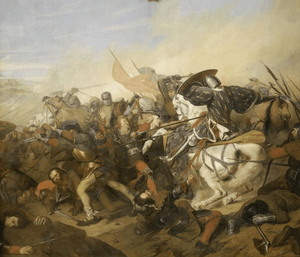 |
|||
| 1343–1345 | St. George's Night Uprising | Estonian peasants | Suppression of the rebellion | 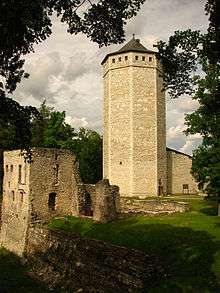 |
[16] | ||
| 1351–1368 | Red Turban Rebellion | Yuan dynasty Goryeo | Red Turban Armies of White Lotus members, Manichaeans and Chinese peasants | Fall of Yuan dynasty and retreat of the Mongols into Mongolia as the Northern Yuan dynasty; ascendancy of rebel leader Zhu Yuanzhang after infighting among rebel forces | |||
| 1358 | Jacquerie | French peasants | Suppression of the rebellion | 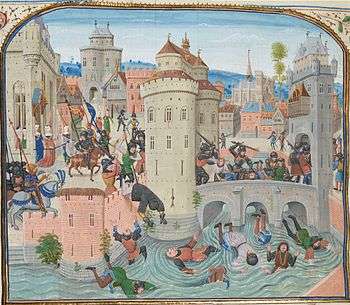 |
|||
| 1381 | Peasants' Revolt | English peasants | Suppression of the rebellion | 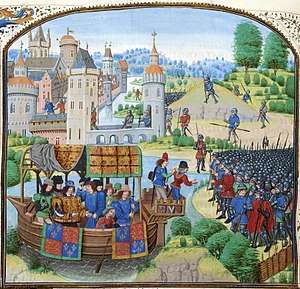 |
|||
| 1382 | Harelle | French peasants | Suppression of the rebellion |  |
[17] | ||
| 1401–1404, 1409 | Samogitian uprisings | Samogitian peasants |
Goal of the rebellion largely achieved, though disputes over Samogitia continue until 1422 | ||||
| 1428 | Shocho uprising | Japanese peasants | Peasant debts cancelled. | ||||
| 1437 | Budai Nagy Antal Revolt | Transylvanian peasants | Suppression of the rebellion | ||||
| 1438 | Hallvard Graatops Revolt | Norwegian rebels | Suppression of the rebellion | ||||
| 1441 | Kakitsu uprising | Do-ikki (leagues) of peasants and jizamurai | Peasant debts cancelled, Ashikaga shogunate is severely weakened. | 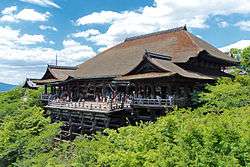 |
[18] | ||
| 1441 | Funen and Jutland Peasant rebellions | Danish peasants | Suppression of the rebellion | 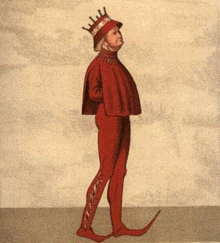 |
|||
| 1450 | Jack Cade Revolt | English peasants | Suppression of the rebellion |  |
[19] | ||
| 1450–1451 | John and William Merfold's Uprising | English peasants | Suppression of the rebellion |  |
[20] | ||
| 1453–1454 | Morea revolt of 1453–54 | Greek peasants under Manuel Kantakouzenos Albanians under Peter Bua |
Suppression of the rebellion | [21] | |||
| 1462–1472, 1485–1486 | War of the Remences | Catalan peasants |
Goal of the rebellion largely achieved, Sentència de Guadalupe signed |  |
[22] | ||
| 1478 | Carinthian Peasant Revolt | Carinthian peasants | Suppression of the rebellion | [23] | |||
| 1482–1511 | Yamashiro-ikki uprisings | Yamashiro peasant leagues Hatakeyama clan |
Most ikki submit to the shogunate in 1493, though continue to retain autonomy until gradual dissolution of the movement | [24] | |||
| 1487–1488 | Kaga Rebellion | Togashi clan | Ikkō-ikkiMotoori clanYamagawa clan | Decisive victory for the Ikkō-ikki. | 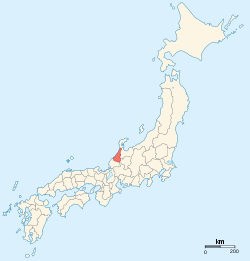 |
[25] | |
| 1488–1582 | Ikkō-ikki Uprisings | Several major samurai clans (including Oda clan and Tokugawa clan) Nichiren sect Tendai sōhei Jōdo-shū sōhei | Ikkō-shū peasant and ji-samurai leagues Jōdo Shinshū sōhei |
Destruction of most militant Ikkō-shū leagues; Jōdo Shinshū sect and remaining Ikkō-ikki submit to Toyotomi Hideyoshi | [26] | ||
| 1498–1878 | Opryshky movement | Ukrainian peasants | Suppression of the movement | 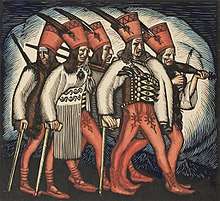 |
|||
| 1511 | Friulian Revolt | Friulian peasants | Suppression of the rebellion | 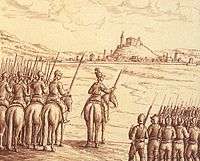 |
|||
| 1514 | Poor Conrad Rebellion | Württemberg peasants | Suppression of the rebellion | 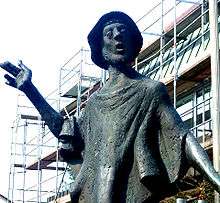 |
[27] | ||
| 1514 | György Dózsa Rebellion | Hungarian peasants | Suppression of the rebellion | 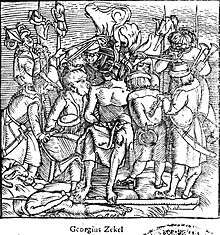 |
[28] | ||
| 1515 | Slovene Peasant Revolt | Slovene peasants | Suppression of the rebellion | [29] | |||
| 1515–1523 | Frisian peasant rebellion | Suppression of the rebellion | |||||
| 1516–1521 | Trần Cảo Rebellion | Lê dynasty | Vietnamese peasants under Trần Cảo and Trần Cung | Suppression of the rebellion, though Lê dynasty is severely weakened | [30] | ||
| 1524–1525 | German Peasants' War | German peasants | Suppression of the rebellion | 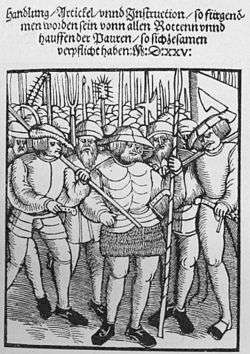 |
|||
| 1524–1533 | Dalecarlian Rebellions | Dalarna peasants | Suppression of the rebellion | 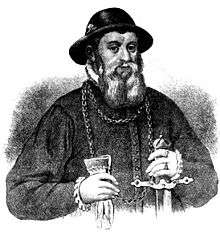 |
|||
| 1525 | Palatine Peasants' War | Palatine peasants | Suppression of the rebellion | 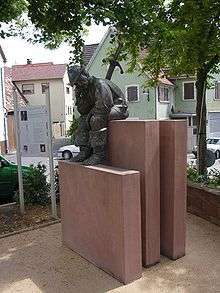 |
|||
| 1534 | Skipper Clement's Rebellion | Danish Peasants under Skipper Clement |
Suppression of the rebellion | 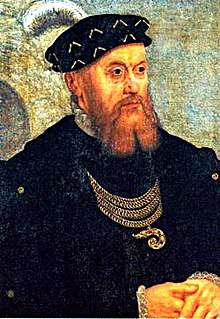 |
|||
| 1540 | Peasant's Rebellion in Telemark | Norwegian peasants | Suppression of the rebellion | ||||
| 1542–1543 | Dacke War | Småland peasants | Suppression of the rebellion | [31] | |||
| 1549 | Kett's Rebellion | English peasants | Suppression of the rebellion | 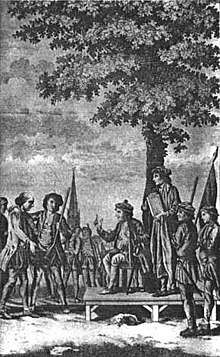 |
|||
| 1573 | Croatian–Slovene Peasant Revolt | Slovene peasants Croatian peasants | Suppression of the rebellion | .jpg) |
[32] | ||
| 1596–1597 | Cudgel War | Finnish peasants | Suppression of the rebellion | [33] | |||
| 1606–1607 | Bolotnikov Rebellion | Russian peasants | Suppression of the rebellion | 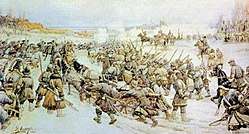 |
|||
| 1626–1636 | Peasants' War in Upper Austria | Austrian peasants | Suppression of the rebellion | 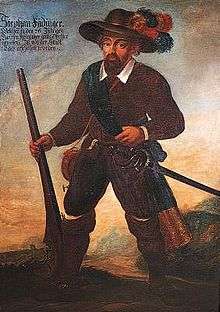 |
[34] | ||
| 1630–1645 | Rebellion of Li Zicheng | Ming dynasty (1630–1644) |
Peasants under Li Zicheng, Gao Guiying and other generals of the Shun dynasty | Collapse of Ming dynasty, but suppression of the rebellion by Qing dynasty | |||
| 1630–1647 | Rebellion of Zhang Xianzhong | Ming dynasty (1630–1644) |
Peasants and bandits under Zhang Xianzhong | Collapse of Ming dynasty, but suppression of the rebellion by Qing dynasty | [35] | ||
| 1637–1638 | Shimabara Rebellion | Christian peasants and rōnin | Suppression of the rebellion | 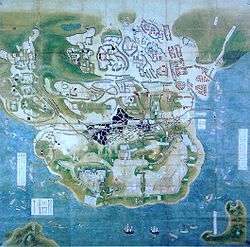 |
[36] | ||
| 1651 | Kostka-Napierski Uprising | Polish peasants | Suppression of the rebellion |  |
[37] | ||
| 1652 | Guo Huaiyi Rebellion | Dutch East India Company Aboriginal Taiwanese | Chinese peasants | Suppression of the rebellion | |||
| 1653 | Swiss peasant war of 1653 | Swiss peasants | Suppression of the rebellion |  |
[38] | ||
| 1667–1671 | Stepan Razin Rebellion | Russian peasants Don Cossacks | Suppression of the rebellion | 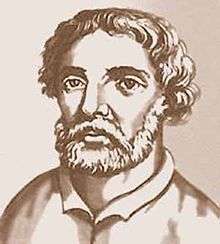 |
[39] | ||
| 1669–1670 | Peasant Rebellion in Podhale | Polish peasants | Suppression of the rebellion | 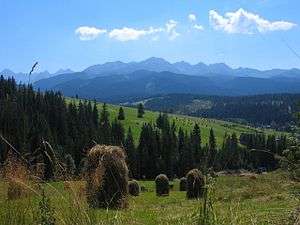 |
[40] | ||
| 1704 | Kuridža's Rebellion | Orthodox peasants | Suppression of the rebellion | ||||
| 1705–1706 | Bavarian People's Uprising | Bavarian peasants | Suppression of the rebellion | 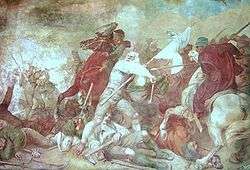 |
|||
| 1707–1708 | Bulavin Rebellion | Russian peasants Don Cossacks | Suppression of the rebellion | ||||
| 1730–1769 | Peasant revolts for the restoration of the Lê dynasty and land reforms | Trịnh lords Nguyễn lords | Vietnamese peasants Lê dynasty | Suppression of the rebellions and eventual collapse of Lê dynasty, but start of Tây Sơn Revolt | |||
| 1768–1769 | Koliyivshchyna | Haidamaka movement | Suppression of the rebellion | ||||
| 1769–1788 | Tây Sơn Revolt | Nguyễn lords (until 1776) Nguyễn Ánh's forces (since 1776) Trịnh lords (until 1786) Lê dynasty (1786-1788) |
Tây Sơn dynasty | Goal of the rebellion achieved; reunification of Vietnam and introduction of land reforms under Tây Sơn dynasty | 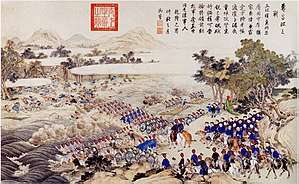 |
||
| 1773–1775 | Pugachev's Rebellion | Russian peasants Ural Cossacks Bashkirs | Suppression of the rebellion |  |
[41] | ||
| 1784 | Revolt of Horea, Cloșca and Crișan | Romanian peasants | Suppression of the rebellion | 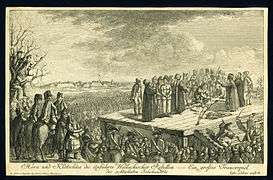 |
[42] | ||
| 1786–1787 | Shays' Rebellion | American farmers | Suppression of the rebellion | 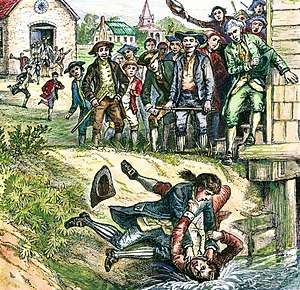 |
|||
| 1790 | Saxon Peasants' Revolt | Saxon peasants | Suppression of the rebellion | 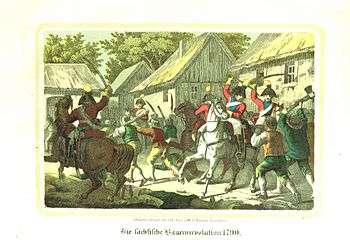 |
[43] | ||
| 1793–1796 | War in the Vendée | Suppression of the rebellion | 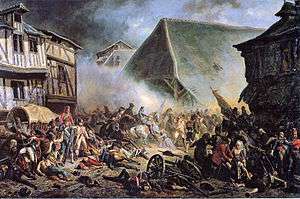 |
||||
| 1793–1804 | Chouannerie | Suppression of the rebellion | 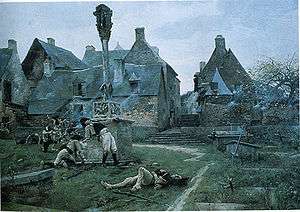 |
||||
| 1794 | Kościuszko Uprising | Suppression of the rebellion |  |
[44] | |||
| 1794–1804 | White Lotus Rebellion | White Lotus rebels | Suppression of the rebellion | ||||
| 1798 | Peasants' War | Suppression of the rebellion | 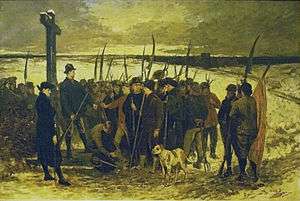 |
[45] | |||
| 1809 | Tyrolean Rebellion | Suppression of the rebellion |  |
||||
| 1809 | Gottscheer Rebellion | Suppression of the rebellion | |||||
| 1834–1835 | Syrian Peasant Revolt (1834–35) | Arab peasants | Suppression of the rebellion | [46] | |||
| 1846 | Galician slaughter | Polish peasants | De facto suppression of the rebellion, although it was sparked and extinguished by the Austrian authorities and eventually led to abolition of serfdom in Galicia and Lodomeria two years later. | [47] | |||
| 1850–1864 | Taiping Rebellion | Taiping Heavenly Kingdom | Suppression of the rebellion |  |
|||
| 1858 | Mahtra War | Estonian peasants | Suppression of the rebellion | [48] | |||
| 1862 | Great Peasant Uprising of 1862 | Korean peasants | Suppression of the rebellion | ||||
| 1884 | Chichibu Incident | Japanese peasants | Suppression of the rebellion |  |
|||
| 1894–1895 | Donghak Peasant Revolution | Korean peasants | Suppression of the rebellion | ||||
| 1896–1897 | War of Canudos | Canudos inhabitants | Suppression of the rebellion | 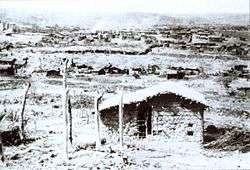 |
|||
| 1905–1908 | Maji Maji Rebellion | Matumbi people, Ngoni people, and other Tanganyikans | Suppression of the rebellion | 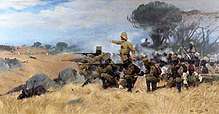 |
[49] | ||
| 1907 | 1907 Romanian Peasants' Revolt | Romanian peasants | Suppression of the rebellion | ||||
| 1911 | Peasant rebellion in eastern Henan | Yellow Way Society | Suppression of the rebellion | [50][51] | |||
| 1913 | Peasant revolt in Northern Shaanxi | Chinese poppy farmers and bandits under a sect leader | Spread of the revolt; poppy plant eradication campaign stopped | [52] | |||
| 1914 | Peasant Revolt in Albania | Muslim peasants | Suppression of the rebellion | .jpg) |
|||
| 1916 | Urkun | Kyrgyz and Kazakh peasants | Suppression of the rebellion | [53] | |||
| 1917 | October Revolution | Russian peasants and workers | Beginning of the Russian Civil War |  |
|||
| 1918 | Arsk Uprising | Tatar peasants | Suppression of the rebellion | ||||
| 1919–1922 | Rebellion of "Chu the Ninth" (Ming pretender) | Yellow Way Society | Suppression of the rebellion | [54] | |||
| 1920 | Pitchfork uprising | "Black Eagle" rebels | Suppression of the rebellion | ||||
| 1920–1921 | Tambov Rebellion | Suppression of the rebellion | |||||
| 1921 | Peasant Rebellion of Sorokino | Russian peasants and White Army veterans | Suppression of the rebellion | ||||
| 1921 | Malabar rebellion | Indian peasants | Suppression of the rebellion | 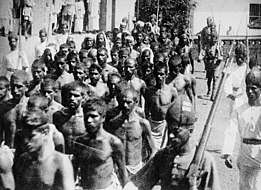 |
[55] | ||
| 1924 | Rebellion of "Wang the Sixth" (Ming pretender) | Wang's followers | Suppression of the rebellion | [54] | |||
| 1925 | Rebellion of Chu Hung-teng (Ming pretender) | Heavenly Gate Society | Suppression of the rebellion | [56] | |||
| 1927 | Autumn Harvest Uprising | Suppression of the rebellion | |||||
| 1928–1929 | Red Spears' uprising in Shandong | Red Spear Society | Suppression of the rebellion | [57] | |||
| 1932 | Salvadoran peasant massacre | Salvadoran peasants | Suppression of the rebellion | 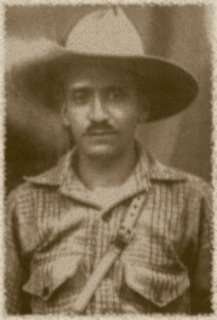 |
|||
| 1932 | Lesko uprising | Polish peasants | Suppression of the rebellion | [58] | |||
| 1932 | Peasant uprising against poppy-tax collection in Su County | Chinese poppy farmers and gentry under Wang Xiaobai and Ma Fengshan | Suppression of the rebellion | [59] | |||
| 1932 | Peasant uprising against poppy-tax collection in Lingbi County | Chinese poppy farmers under Tian Xuemin | Goal of the rebellion achieved | [60] | |||
| 1936 | Miyun District rebellion | Yellow Sand Society | Suppression of the rebellion | [61][62] | |||
| 1944 | Peasant revolt in Beichuan County | Chinese poppy farmers of Xiaoyuan and Houyuan | Goal of the rebellion achieved | [63] | |||
| 1946–1951 | Tebhaga movement | Bengal landlords | Bengal peasants (All India Kisan Sabha) |
Goal of the rebellion partially achieved | [64] | ||
| 1946–1951 | Telangana Rebellion | Hyderabad peasants (Andhra Mahasabha) |
Goal of the rebellion achieved | [65] | |||
| 1950 | Cazin rebellion | Yugoslavian peasants | Suppression of the rebellion | [66] | |||
| 1952–1960 | Mau Mau Uprising | Kikuyu farmhanders | Suppression of the rebellion | 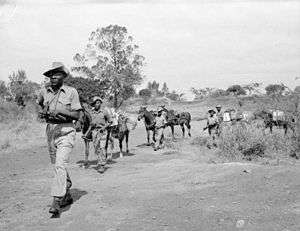 |
|||
| 1959–1965 | Escambray Rebellion | Cuban peasants |
Suppression of the rebellion | ||||
| 1968–1969 | Agbekoya | Yoruba peasants | Goal of the rebellion achieved | ||||
| 1970s | 1970s peasant revolts in Thailand | Thai peasants | Peasant leaders assassinated |  |
|||
| 1975–1991 | Uprisings in Tigray and Eritrea; part of the Ethiopian Civil War | Tigrayan and Eritrean peasants | Derg overthrown; Eritrean independence | [67] | |||
| 1994 | Zapatista uprising | Mexican indigenous peasants | Ceasefire | 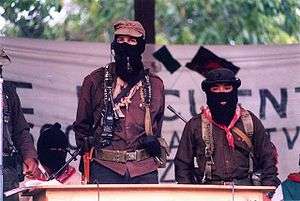 |
See also
References
- ↑ Frantisek Graus (5 February 2008). "The Late Medieval Peasant Wars". The Journal of Peasant Studies. 3: 1–9. doi:10.1080/03066157508437962. Retrieved 22 October 2014.
- ↑ Theda Skocpol (April 1982). "Review: What Makes Peasants Revolutionary?" (PDF). Retrieved 22 October 2014.
- ↑ "Peasant Rebellions". Danmarkshistorien-Aarhus University. Retrieved 20 October 2014.
- ↑ "Chen Sheng and Wu Guang's Revolt Against Qin". Retrieved 22 October 2014.
- ↑ "The great revolt of the Egyptians (205–186 BC)". Archived from the original on 3 March 2016. Retrieved 8 June 2015.
- ↑ Dio Cassius, Epitome 72
- ↑ Ulrich Theobald (28 June 2011). "The Yellow Turban Uprising". Retrieved 22 October 2014.
- ↑ Baldwin, p. 3-11.
- ↑ Somers, p. 688-692.
- ↑ Somers, p. 727-736.
- ↑ Somers, p. 727-762.
- ↑ Kazhdan 1991, pp. 268–269
- ↑ "Die Nördliche Song-Dynastie". Retrieved 17 June 2015.
- ↑ Gowers, Bernard (1 February, 2013). "996 and All That: The Norman Peasants' Revolt Reconsidered." Early Medieval Europe 21(1): 71-98. Retrieved 21 June 2016.
- ↑ Andreev, p. 221-228.
- ↑ Vahtre, p. 79-90.
- ↑ Sumption, p. 444.
- ↑ Hall, Toyoda; pp. 28-30.
- ↑ Thomson, p. 195-297.
- ↑ Hicks, p. 33-55.
- ↑ Cheetham, p. 218.
- ↑ Rotger, 2011, p. 26-33.
- ↑ Štih, Peter (2000). "Kmečki upor na slovenskem Koroškem" [The Peasant Revolt in Slovene Carinthia]. In Vidic, Marko. Ilustrirana zgodovina Slovencev [The Illustrated History of the Slovenes] (in Slovenian). Mladinska knjiga. p. 132. ISBN 86-11-15664-1.
- ↑ Berry, p. 37-44.
- ↑ Sugiyama 1994, p. 62.
- ↑ Otani, p. 609-612.
- ↑ "Der Aufstad des Armen Konrad". Gechichtsverein Kongen. 2013. Retrieved 22 October 2014.
- ↑ "Dózsa Rebellion". Encyclopædia Britannica. Retrieved 22 October 2014.
- ↑ Štih, Peter (2000). "Slovenski kmečki upor" [The Slovene Peasant Revolt]. In Vidic, Marko. Ilustrirana zgodovina Slovencev [The Illustrated History of the Slovenes] (in Slovenian). Mladinska knjiga. p. 142. ISBN 86-11-15664-1.
- ↑ Cooke, Vietnamese Confucianization, pp. 289–292.
- ↑ "Dacke War". Encyclopædia Britannica. Retrieved 22 October 2014.
- ↑ "Губеца Матии восстание 1573". Большая Советская Энциклопедия. Retrieved 22 October 2014.
- ↑ Veli Niinimaa. "Jaakko Ilkka". Retrieved 22 October 2014.
- ↑ "Bauernaufstände in Oberösterreich – Einleitung". Verbundes Oberösterreichischer Museen (in German). Retrieved 14 August 2013.
- ↑ "Chang Hsien-chung". Eminent Chinese of the Ch'ing Period. Qing Research Portal, Dartmouth College. Retrieved 22 June 2015.
- ↑ Murray, Japan, pp. 258–262.
- ↑ Majda, p. 17-30.
- ↑ Suter, p. 146-155.
- ↑ Avrich, Paul (1976). Russian Rebels, 1600-1800. New York: Schocken Books. pp. 83–117. ISBN 9780393008364.
- ↑ Jacek Pędzimąż (17 May 2009). "Rzeczpospolita Podhalańska 1669/1670". Retrieved 21 June 2015.
- ↑ Forster, Robert (1970). Preconditions of Revolution in Early Modern Europe. Baltimore: Johns Hopkins. pp. 163–181.
- ↑ Pascu, p. 534-537.
- ↑ "Sächsischer Bauernaufstand 1790". Bauerkriege. 28 June 2011. Retrieved 20 June 2015.
- ↑ Żygulski; Wielecki, p. 49.
- ↑ Kreins, p. 66-70
- ↑ Manna, 2009, p. 85-96.
- ↑ Jerzy Lukowski; Hubert Zawadzki (6 July 2006). A Concise History of Poland. Cambridge University Press. p. 170. ISBN 978-0-521-85332-3. Retrieved 4 April 2013.
- ↑ Raun, p. 45-60.
- ↑ Iliffe, p. 68-176.
- ↑ Xing & Li (1991), p. 64–69.
- ↑ Billingsley (1988), p. 49.
- ↑ Bianco, p. 110.
- ↑ Bruce Pannier (2 August 2006). "Kyrgyzstan: Victims Of 1916 'Urkun' Tragedy Commemorated". RFE/RL. Retrieved 2006-08-02.
- 1 2 Perry (1980), p. 159.
- ↑ "Battle of Pookottur commemorated". The Hindu. Chennai, India. 27 August 2009. Retrieved 20 June 2015.
- ↑ Tai (1985), p. 68.
- ↑ Bianco (2015), pp. 5–9.
- ↑ Głuszko, p. 71-79.
- ↑ Bianco, p. 76-96.
- ↑ Bianco, p. 76-96.
- ↑ Morning Tribune Staff (1936), p. 9.
- ↑ The China Monthly Review Staff (1936), p. 473.
- ↑ Wakabayashi; Brook, p. 110.
- ↑ Majumdar, p. 13.
- ↑ "Hyderabad 1948: India's hidden massacre". BBC News. 24 September 2013. Retrieved 20 June 2015.
- ↑ "Dokumentarni film o Cazinskoj buni na cazin.NET". Cazin. 6 May 2012. Archived from the original on 9 May 2012. Retrieved 11 February 2014.
- ↑ John Young, Peasant Revolution in Ethiopia: The Tigray People's Liberation Front, 1975–1991 (Cambridge: Cambridge University Press, 1997).
Sources
- Berry, Baldwin (1962), "Peasant Revolt in Africa in the Late Roman Empire", in Lewis Thorpe, Nottingham Medieval Studies Vol. VI, W. Heffer & Sons Ltd., Cambridge
- Bianco, Lucien (2015). Peasants without the Party: Grassroots Movements in Twentieth Century China. Abingdon-on-Thames, New York City: Routledge. ISBN 978-1563248405.
- Billingsley, Phil (1988). Bandits in Republican China. Stanford, California: Stanford University Press.
- Sumption, Jonathan (2009). The Hundred Years War: Divided Houses. University of Pennsylvania Press. ISBN 978-0-8122-4223-2.
- Raun, Toivo (2001). Estonia and the Estonians. Hoover Press. ISBN 978-0-8179-2852-0.
- Głuszko,Mariusz (2008). Bieszczady z historią i legendą w tle. Sandomierz.
- Vahtre, Sulev (1960). Bartholomäus Hoeneke: Liivimaa noorem riimkroonika. Eesti Riiklik Kirjastus.
- Thomson, John A.F. (1983). The Transformation of Medieval England 1370-1529. Longman.
- Majda, Jan (1981). Literatura o Tatrach i Zakopanem (do roku 1918). Ossolineum-PAN Krakow. ISBN 83-04-00863-7.
- Hicks, Michael (2010). The Wars of the Roses. Yale University Press.
- Otani, Chojun (1968). Le mouvement insurrectionnel des Ikko-Ikki, adeptes de la secte Bouddhique Shin-Shu au XVème et au XVIème siècle. École pratique des hautes études.
- Andreev, J. (1996). Българските ханове и царе. Veliko Tarnovo. ISBN 954-427-216-X.
- Pipes, Richard. (1993). Russia under the Bolshevik regime.
- Berry, Mary Elizabeth. (1997). The Culture of Civil War in Kyoto. ISBN 9780520208773.
- Kazhdan, Alexander Petrovich (1991). "Basil the Copper Hand". In Kazhdan, Alexander Petrovich. Oxford Dictionary of Byzantium. New York, New York and Oxford, United Kingdom: Oxford University Press. pp. 268–269. ISBN 978-0-19-504652-6.
- Murray, David (1905). Japan. G.P. Putnam's Sons.
- Makhno, Peter Mikhail (2014) Crown Whims and Farmers' Endurance; Militarization, Over-Taxation and Farmers' Resistance in Denmark-Norway ca. 1500-1800. Nisus Publications.
- Suter, Andreas, ed. (2004). Kollektive Erinnerungen an historische Ereignisse – Chancen und Gefahren. Der Bauernkrieg als Beispiel. Zürich: Orell Füssli Verlag. pp. 146–155. ISBN 3-280-06020-6.
- Pascu, Ștefan (1984). Revoluția populară de sub conducerea lui Horea. București: Editura Militară. pp. 534–537.
- Kreins, Jean-Marie (2003). Histoire du Luxembourg (in French) (3rd ed.). Paris: Presses Universitaires de France. ISBN 978-2-13-053852-3.
- Adel, Manna (2009), "Rereading the 1834 Revolt Against Muhammad Ali in Palestine and Rethinking Ottoman Rule", in Kamil Mansur; Leila Tarazi Fawaz, Transformed Landscapes: Essays on Palestine and the Middle East in Honor of Walid Khalid, American University of Cairo Press, ISBN 9789774162473
- Rotger, Agnès (2011). Pagesos contra nobles. Barcelona.
- Iliffe, John (1979). A Modern History of Tanganyika. Cambridge.
- Cheetham, Nicolas (1981), Mediaeval Greece, New Havan & London: Yale University Press, ISBN 0-300-10539-8
- Żygulski, Zdzisław; Wielecki, Henryk. (1988), Polski mundur wojskowy, Kraków, ISBN 8303014838
- Bianco, Lucien (2015). Peasants Without the Party: Grass-Roots Movements in Twentieth-Century China. New York: Routledge.
- Wakabayashi, Bob T.; Brook, Timothy. (2000), Opium Regimes: China, Britain, and Japan, 1839-1952, Los Angeles, Berkley, London: University of California Press, ISBN 0-520-22009-9
- Majumdar, Asok (2011). The Tebhaga Movement : Politics of Peasant Protest in Bengal 1946-1950. Aakar Books. ISBN 978-9350021590.
- Cooke, Nola (September 1994). "Nineteenth-century Vietnamese Confucianization in historical perspective: evidence from the palace examinations (1463–1883)". Journal of Southeast Asian Studies. 25 (2): 270–313. doi:10.1017/S0022463400013515.
- Somers, Robert M. (1979), "The end of the T'ang", in Denis C. Twitchett, The Cambridge History of China Volume 3: Sui and T'ang China, 589–906 AD, Part One, Cambridge University Press, ISBN 9780521214469
- Sugiyama, Shigeki J. (1994). "Honganji in the Muromachi-Sengoku Period: Taking Up the Sword and its Consequences" (PDF). Pacific World. Berkeley, California: Institute of Buddhist Studies. 2 (10): 56–74. Archived from the original (PDF) on 29 April 2014.
- John Whitney Hall; Takeshi Toyoda (1977), Japan in the Muromachi Age, Los Angeles, Berkley, London: University of California Press, ISBN 0-520-02888-0
- Morning Tribune Staff (30 July 1936). "Yellow Sand Cult to be suppressed by Japanese". Morning Tribune. 1 (154). Peiping. p. 9. Retrieved 3 May 2018.
- The China Monthly Review Staff (20 August 1936). ""Yellow Sand" Society Suppressed by Japanese in Demilitarized Zone". The China Monthly Review. 77. Custom House, Shanghai. p. 473.
- Perry, Elizabeth J. (1980). Rebels and Revolutionaries in North China, 1845-1945. Stanford, California: Stanford University Press.
- Xing, Hansan; Li, Guoqiang (1991). "YUDONG HUANGDAO HUI QIYI" [The uprising of the Huangdao Hui in east Henan in 1911]. Shixue Yuekan (Journal of Historical Science) (in Chinese). 5: 64–69.
- Tai, Hsüan-chih (1985). The Red Spears, 1916-1949. Ann Arbor, Michigan: Centre for Chinese Studies Publications, University of Michigan.
This article is issued from
Wikipedia.
The text is licensed under Creative Commons - Attribution - Sharealike.
Additional terms may apply for the media files.